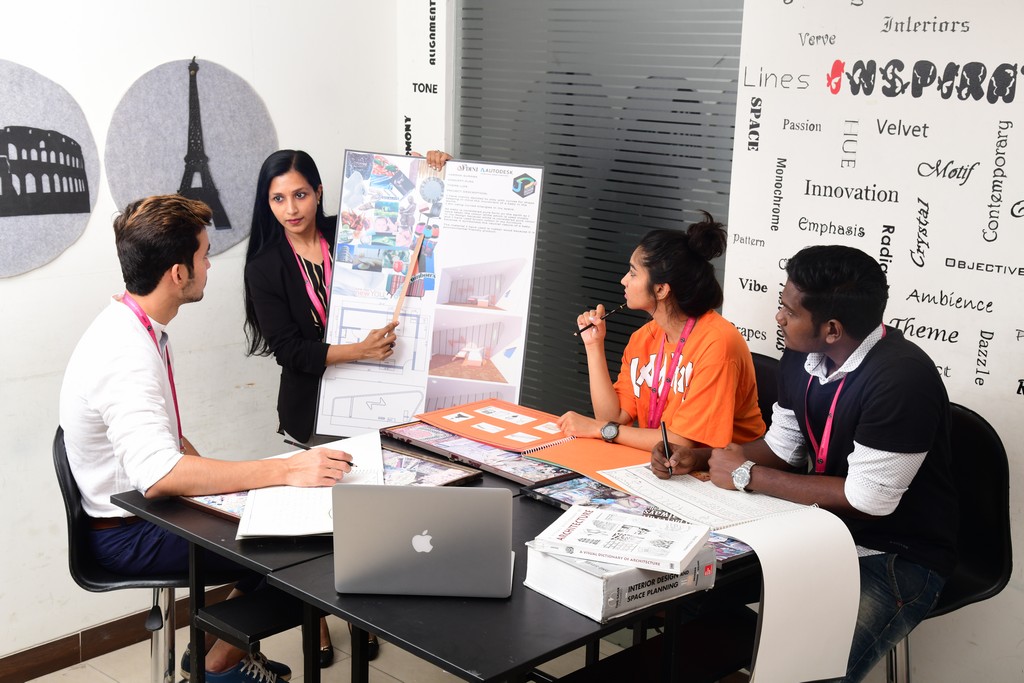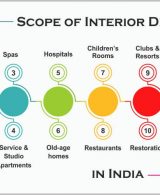Interior Design Subjects: Subjects Required For Interior Designing Course

Subjects Required in Interior Designing: and Some More!
In the modern and urban lifestyle of today, the most popular demands in Indian cities is the need to hire an interior designer.
That being said it can be well understood that Interior Designing is a very attractive course among many students, but what most of them are confused about are:
- How many subjects are involved in the course?
- How long is the course duration?
- What is the eligibility criteria?
These are some of the most frequently asked questions by students and parents alike, and thus in the upcoming sections we will discuss them one by one.
But first, a quick introduction to the course.
What is Interior Designing?
Interior designing in the most basic terminology is a course which equips a professional to evaluate an already existing space and turn it into a functionally, engaging and attractive one. The significance of interior designers being in high demand lies behind the fact that no one wants an empty wall, and an interior designer is the best one to turn an empty canvas into a living piece of art.
What is the Eligibility Criteria to Become an Interior Designer?
If we look from the perspective of Indian educational institutions which offer, the eligibility criteria is as follows:
- Diploma in Interior Designing: 10th pass or equivalent from a recognised institution and governing authority.
- Bachelors in Interior Designing: 12th pass or equivalent from a recognised institution and governing authority.
- Masters in Interior Designing: Bachelors from a recognised institution and governing authority.
Fulfilling any of the above criterion will make an aspiring student eligible for admission in an interior designing course in an educational institution of their choice.
What Subjects are Needed to Become a Interior Designer?
This is one of the most commonly asked questions by students who aspire to become interior designers in the future. While most educational institutions follow a similar pattern, some choose to alter the course here and there to suit the educational goals and current market trends. Mentioned below are details of all the subjects in interior designing course.

Diploma in Interior Design
Students can join the Diploma in Interior Design course right after their 10th exam and this course includes 6 subjects taught in the tenure of 1 year. Mentioned below are the interior design subjects list for the Diploma course.
- Design Skills 1: This subject is aimed at making students understand the basics of design skills and how they can use them further on in the course.
- Art and Graphics: The use of Art and Graphics is an important aspect in interior designing and this subject helps students understand the same.
- Construction and Design: Turning an idea into reality takes the basic understanding of Construction and Design and this subject helps students learn the same.
- Computer-Aided Graphic Design: The use of technology in design is a key aspect of implementing your ideas and this subject introduces the basics of the same to the students.
- Design Skill 2: An advancement on the previous subject, this one helps students understand the more finer details of design and its implementation.
- Interior Design Theory: This final subject aims to give students an understanding of the various theories at work in design.
Clearing all the above mentioned subjects required for interior designing are important to be successful.
B.Des. in Interior Design (Bachelor of Design)
A bachelors course in interior designing has a total course duration of 4 years and all the subjects are divided into 8 semesters.
Semester I
- Fundamentals of Structure 1: As mentioned this course is aimed at teaching patrons the very basics of interior designing.
- Theory of Design: Similar to other professions and career choices, interior designing too is backed up many theories of designing. This course gives students a basic introduction to some of them.
- Freehand Drawing & Geometric Construction: One of the most important subjects in the entire course, this subject teaches students the basics of drawing and geometric construction.
- Material Exposure: Throughout the course as well as professional life, an interior designer will get exposed to various materials, and thus this course introduces some materials to the students in the early stages.
- Communication Skills: One of the most important skills to win in life is communication and this subject teaches students how to communicate effectively and seamlessly.
- Introduction to Computers 1: Technology is a key aspect of interior designing and thus this subject introduces to the students the softwares and technology they will be using throughout the course.
- Fundamentals of Design 1: Design of any scale is based on certain fundamental pillars and this course aims to teach them to the students.
Semester II
- Fundamentals of Structure 2: Forming a structure to a designers idea is one of the most important steps for a perfect execution and this step teaches students and patrons the basics of the same.
- Research Strategies Design Process: Making strategic decisions while working for a client is key to success and this subject teaches students how to form an effective and actionable strategy.
- Analytical Drawing: A subject aimed to teach the students the basics of drawing.
- Basic Photography: Photography is one of the first steps to make an idea come to life and this subject teaches the basics of photography to students.
- Humanities, Art Appreciation and Appraisal: Looking to the past for inspiration is a common approach among creatives of all sorts. This subject teaches students how to get inspired from the works that have already been done in the past.
- Introduction to Computers 2: A build-up on the Semester I subject, this subject introduces advanced technology used in the industry to students.
- Fundamentals of Design 2: A more advanced approach to the Semester I subject, this subject introduces students to the more sophisticated fundamentals of design.
Semester III
- History of Crafts and Interior Design 1: Interior designing has been around since a very long time and thus this subject aims to teach students more about the marvellous works of historic relics and designs.
- Interior Materials 1: Materials to be used for different projects vary with time and need and thus this course teaches students how to identify the need of each of them.
- Anthropometry and Ergonomics: Ergonomics is an important aspect of any professional course and this subject introduces the basics of it to the students.
- Technical drawings and Computer Applications: Once the idea is put on paper, replicating the design on the software is a crucial step and this subject teaches students how to do it best.
- Interior Construction 1: One of the most important steps to bring a design to life is by actually constructing and this subject introduces students to the basics of interior construction.
- Interior Design 1: Drawing an idea on paper and turning it into reality are both different things and this subject helps students understand how to effectively bring their ideas to life.
Semester IV
- Building Services 1: The application of interior designing varies from building to building and this subject helps students understand which design works best in a particular environment.
- Interior Materials 2: A build-up on the previous subject, this subject introduces more advanced materials that students will be regularly using.
- Elective: Poetry and Literature OR Elective: Journalism: An optional subject, this is mainly aimed at providing students a holistic and diverse approach to studying.
- Advance Computer Application: This subject introduces students to some of the most advanced softwares and applications currently being utilized in the interior designing industry.
- Interior Construction 2: A build-up on the previous subject, this subject aims to further the knowledge of students in turning their ideas to life.
- Interior Design 2: This subject is aimed at advancing the patrons knowledge in various design styles and their applications.
Semester V
- Building Services 2: A follow up to the previous semester, this subject advances the patrons knowledge on different building types and what design will suit them best.
- Interior Materials 3: The use of the best material in a scenario is one of the most important skills for an interior designer to learn and this subject advances the patrons knowledge on the same.
- Elective: Dance and Music OR Elective: Theatre and Film Making: An optional subject aimed at diversifying the students knowledge and learning.
- Materials and Processes 1: Knowing what materials works best is one thing, but knowing how to use it effectively is another. This subject introduces the basics of material processing to students.
- Interior Construction 3: This subject advances the student’s knowledge on interior construction from previous semesters.
- Interior Design 3: Designing an effective space is an utmost necessity and this subject advances the students knowledge on how to do it best.
Semester VI
- Building Services 3: An advanced subject for students in Semester VI, this subject is aimed at knowing what design works best in a particular scenario.
- Cost Estimation: Putting forward a quote for a design is essential in convincing a client that you are worth their money and this subject helps students understand the basics of cost estimation.
- Elective: Human Interaction OR Elective: Marketing: An optional subject with choices between Marketing and Human Interaction, this subject helps students learn how to market themselves and get noticed.
- Arts and Crafts: This subject looks into the finer aspects of arts and crafts and how are used for inspiration in design.
- Interior Construction 4: The final advancement in interior construction, this subject teaches students the finer details of interior construction.
- Interior Design 4: A subject aimed at making students understand the various approaches to interior designing.
Semester VII
- Building Services 4: A final advancement on building services, this subject focuses on the finer details of this aspect.
- Professional Practice: Once a student graduates, they can either work on their own or work for an agency and this subject helps them choose that they want to do and how to do it right.
- Specifications and Controls: Control over the design based on specific aspects is a deal breaker. This subject helps students learn how to keep track and control over their ideas and its execution.
- Product Semantics: Building a product which is the consumer loves and appreciates takes a lot of work and the Product Semantics subject aims to help students understand the basics of this aspect.
- Interior Landscape: Landscapes and canvases are an important aspect of any designing. This course helps students understand various landscapes and how they work.
- Interior Design 5: A final advancement on the finer details of interior design.
Semester VIII
- Seminar-Thesis Topic: This subject gives students a topic to choose from on which they will base their research and thesis.
- Dissertation (Case Study): Case studies are important to understand how designs work and this subject teaches students how to understand case studies and make one of their own.
- Interior Design – Topic: The final subject in the course, this subject aims to review the student’s learning and understanding throughout the span of the course.
Conclusion
No matter which course a student aspires to study, both the Diploma and a Bachelorette degree makes them competent for the industry of today and the future.









